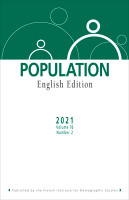
Population 2021, n 2
2021, 106 pages
Population Ageing in High-Longevity Countries: Demographic Dynamics and Socio-economic Challenges
Carole Bonnet, Emmanuelle Cambois, Roméo Fontaine
Residential or In-Home Care for Disabl ed Older Adults: The Role of Geographical Context
Amélie Carrère
How Does Migration Affect Under-5 Mortality in Rural Areas? Evidence from Niakhar, Senegal
Ulrich Nguemdjo, Bruno Ventelou
Population Ageing in High-Longevity Countries: Demographic Dynamics and Socio-economic Challenges
Carole Bonnet, Emmanuelle Cambois, Roméo Fontaine
In 2015, the French law on the adaptation of society to ageing signaled the country’s political will to prepare comprehensively for the consequences of population ageing. It formalized the findings of international research and public debates that have long emphasized its scope and multiple implications. This article reviews these issues by drawing on the experience of 40 high-longevity countries. In 2020, there were 4 times as many people
aged 65 and older as there were in 1950; in Japan, the ‘oldest’ country, their proportion has jumped from 5% to 28%, and life expectancy has nearly doubled. The first part of this article lays out the definitions and measures of population ageing, then describes the diversity of the dynamics of these high-longevity countries. The second part examines the multidimensional and intertwined issues at stake, regarding health (What is the limit to longevity? How is life expectancy in good health changing?), demography (How are family and partnership configurations changing?), and the economy via the problematics of social protection models (retirement, assisted living, intergenerational transfers).
Residential or In-Home Care for Disabl ed Older Adults: The Role of Geographical Context
Amélie Carrère
Population ageing raises the question of long-term care arrangements for disabled older adults, be it in their own homes or in a residential facility. Analysis of trade-offs in the long-term care market is especially interesting for France, where old-age policy is managed at the département level. This decentralized system may give rise to geographical inequality in access to care because not all departments are equally endowed with resources
to offer the desired levels of care provision. This article analyses the determinants residential care access by combining data on long-term care services from two surveys and from administrative sources. To identify the constraints that weigh upon individual choices, multilevel models are used to examine how needs, income,and informal and formal care shape geographical inequalities in residential care provision. This study reveals
substantial differences in the probability of living in a care home, due partly to geographical disparities in the availability of formal care, further accentuated by disparities in out-of-pocket costs.
How Does Migration Affect Under-5 Mortality in Rural Areas? Evidence from Niakhar, Senegal
Ulrich Nguemdjo, Bruno Ventelou
Exploring rich panel data from the Niakhar Health and Demographic Surveillance System, this study investigates the effects of migration on child mortality among families left behind in rural areas. Migration, particularly short-term, is positively associated with the survival probability of under-5 children in the household. We also find that the short-term moves of working-age women impact child mortality more than those of working-age
men. Moreover, we detect crossover effects between households in the same compound, consistent with the idea that African rural families share part of their migration-generated gains with an extended community of neighbours. Lastly, we investigate the effect of maternal short-term migration on the survival of under-5 children. The aggregate effect is still positive but much weaker. Specifically, maternal migration during pregnancy seems to enhance children’s survival immediately after birth, but the probability of survival tends to decrease after age 1 when the mother is absent.

